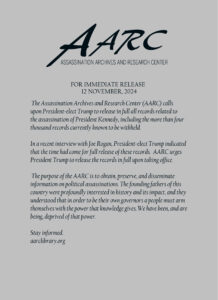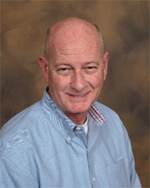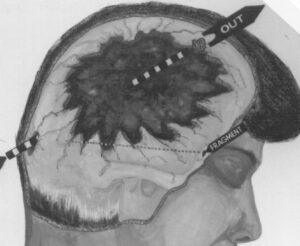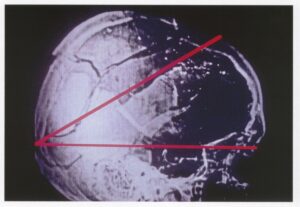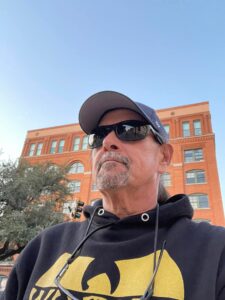DR. RANDY ROBERTSON: Parkland Versus Bethesda; A Requiem
The AARC presents a new series of lectures commemorating and honoring the legacy of President Kennedy, the inspirational meaning of his term of office, and the consequences of his assassination sixty-one years ago.
In the words of the distinguished British scholar Malcolm Blunt, “Jesus Christ, what we lost when we lost that man.”
For decades a meme in the JFK assassination has been the supposed discrepancy in the rearward extent of bone loss in JFK’s head between the doctors and nurses who attended him at Parkland Hospital and the extent of the wounds documented at BNMC. The case for the larger rearward defect was based upon Parkland eyewitness descriptions, photographically depicted in Robert Groden’s book The Killing of a President and a single erroneous measurement on the autopsy descriptive sheet filled out at Bethesda.
To put this in perspective, the argument should be between the Parkland personnel versus Dealey Plaza, the Zapruder film and the autopsy photos and x-rays. This is a classic case of eyewitness error versus the photographic documentation which exists from both before and after Parkland personnel made their individual assessments. This is not to argue that there wasn’t an exit wound in the rear of the head, just simply its extent.
This over estimation in bone loss by Parkland doctors has been used to try to convince individuals that the x-rays and photos must be fake since they differ from eyewitness observations. The pictorial display in Groden’s book has a series of Parkland personnel waving their hands behind their heads in an attempt to show how far back bone loss extended. Without a mirror they had no idea where their hands were actually placed. As such there is variability in each individual assessment. Moreover, in 1988 Nova had four physicians: Dulaney, Peters, McClelland and Jennings, view the original authenticated autopsy photos and all four found no discrepancy between what they recalled at Parkland and the autopsy photos taken at Bethesda.
What we are assessing is bone loss and for that we can look at the Zapruder film which shows where and when skull fragments were ejected. After the first shot to the head from behind, four fragments were ejected from the mid right skull forward. The rearward extent of this initial bone loss is defined by the Harper fragment which was exploded out into Dealey Plaza, as was the more forward located Weitzman fragment. [1,2]
Harper skull fragment being ejected from JFK’s head on the Zapruder film
Weitzman skull fragment tracked after being ejected from JFK’s head out into Dealey Plaza
The Harper fragment’s origin in the right mid-parietal bone has been determined by F.B.I. photos showing characteristic arterial grooves on its inner surface which anatomically allows its placement. This is exactly where it can be seen arising on the film. This also debunks the mistaken belief that the Harper fragment is occipital bone. This assertion made by a Dallas pathologist who examined it but rendered his opinion without having seen the Zapruder film or the autopsy photos and x-rays. After this initial explosion, the rear of JFK’s head is undisturbed and no rearward expulsion of bone has occurred. [3]
 Very shortly after another bullet struck the top rear which had been fired from the front. This is the only bullet which could have caused bone loss in the rear of the head. It is known where this bullet impacted because there is a 6.5 mm metallic particle centrally located to a series of fractures radiating outwards from this same point which is located at the top rear of the head.
Very shortly after another bullet struck the top rear which had been fired from the front. This is the only bullet which could have caused bone loss in the rear of the head. It is known where this bullet impacted because there is a 6.5 mm metallic particle centrally located to a series of fractures radiating outwards from this same point which is located at the top rear of the head.
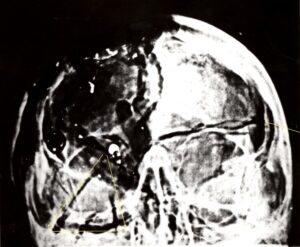 The impact dislodged a single large triangular skull fragment, the Delta fragment, backwards out onto the trunk of the limo.
The impact dislodged a single large triangular skull fragment, the Delta fragment, backwards out onto the trunk of the limo.
Delta skull fragment bearing an exit wound on JFK limo trunk
No other skull fragments are seen ejected from the rear. In one corner of this large fragment multiple small metallic particles were deposited from the same bullet which had left the 6.5 mm metallic particle in the top rear of the head.
In addition, there was external beveling in this same corner indicative of an exit wound. The Delta fragment determines the rearward extent of bone loss which was forward of the higher impact point. Nearly the entirety of bone loss was compromised by the total of five recovered skull fragments. [8]
 On the post-mortem skull x-rays there are no metallic particles low in the rear which could have caused lower bone loss as suggested by the Parkland eyewitnesses.
On the post-mortem skull x-rays there are no metallic particles low in the rear which could have caused lower bone loss as suggested by the Parkland eyewitnesses.
Now we can turn our attention to the findings at BNMC. The skull x-rays taken shortly after JFK’s arrival show the 6.5 mm metallic particle at the top rear with fractures radiating outward with two prominent ones, measuring 6 and 4 cm, extending downward into the still present right occipital bone. If occipital bone had been missing, you wouldn’t be able to see the fracture lines.
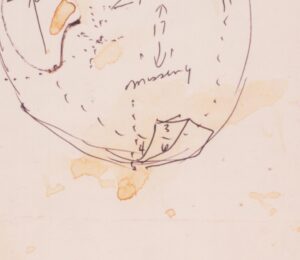 The damage to the skull was diagrammed by the autopsy team and they diagrammed the 6 by 4 by 3 cm fragment of occipital bone.
The damage to the skull was diagrammed by the autopsy team and they diagrammed the 6 by 4 by 3 cm fragment of occipital bone.
 One measurement on the autopsy descriptive sheet, which has been cited as evidence for greater bone loss is a notation of “10 by 17 cm missing” with the 17 cm dimension representing the forward to rearward bone loss. If true this would indicate bone loss beneath the higher impact point. This is contradicted by the photos and x-rays showing the occipital bone to be present and by the 6 by 4 by 3 cm measurement of fractures in the right occipital bone noted on the same descriptive sheet. The apex of this triangular bone fragment can also be seen in the photos of the interior of the rear of the skull. Intact but fractured occipital bone, as seen on the x-rays, photos and the 6 by 4 by 3 cm notation is incompatible with the “10 by 17 cm missing” from front to rear. The autopsy report itself says that the greatest dimension of bone loss was 13 cm not 17 cm. 13 cm of bone loss in the anterior/posterior dimension is entirely compatible with the bone loss seen on the x-rays as well as the Zapruder film’s documentation of skull fragments lost from the wounds. The 13 cm measurement may well have been included in the notes that Humes burned. The illustrations of the damage to JFK’s head made for the Warren Commission show the occipital bone present as well.
One measurement on the autopsy descriptive sheet, which has been cited as evidence for greater bone loss is a notation of “10 by 17 cm missing” with the 17 cm dimension representing the forward to rearward bone loss. If true this would indicate bone loss beneath the higher impact point. This is contradicted by the photos and x-rays showing the occipital bone to be present and by the 6 by 4 by 3 cm measurement of fractures in the right occipital bone noted on the same descriptive sheet. The apex of this triangular bone fragment can also be seen in the photos of the interior of the rear of the skull. Intact but fractured occipital bone, as seen on the x-rays, photos and the 6 by 4 by 3 cm notation is incompatible with the “10 by 17 cm missing” from front to rear. The autopsy report itself says that the greatest dimension of bone loss was 13 cm not 17 cm. 13 cm of bone loss in the anterior/posterior dimension is entirely compatible with the bone loss seen on the x-rays as well as the Zapruder film’s documentation of skull fragments lost from the wounds. The 13 cm measurement may well have been included in the notes that Humes burned. The illustrations of the damage to JFK’s head made for the Warren Commission show the occipital bone present as well.
SS agent Roy Kellerman, from eyewitness observation at the autopsy, told the Warren Commission that there was 1 ½ to 2 inches of bone above the lower entry hole entirely consistent with the x-rays and Boswell’s 6 by 4 by 3 cm notation. The “10 by 17 cm missing” notation, contradicted by multiple other avenues of evidence, is the only item which can be cited to support bone loss low in the rear of the skull outside the varying amounts of bone loss the Parkland personnel claimed to have seen.
Given this, is there another interpretation of the “10 by 17 cm missing” notation? I believe there is. The autopsy team stated that, during their manipulation of the scalp, fragments of skull fell to the table. If the 6 by 4 by 3 cm isolated bone fragment had been one of these which fell to the table before this measurement was taken then 10 by 17 cm could have been noted as missing.
A special note should be made of a specific observation at Parkland made by the head of neurosurgery, Dr. Kemp Clark. He stated that both cerebral and cerebellar tissue was seen extruding from the head wound. The bullet fired from behind entered just above the cerebellum and while there are no metallic fragments low in the rear of the skull, as this was a jacketed bullet, the temporary pressure cavity created by this bullet’s passage could have disrupted cerebellar tissue. This has nothing to say about the absence of occipital bone as its presence is well documented on the post-mortem skull x-rays. The photographs taken of JFK’s brain show the cerebellum to be intact; however, the photos have no identification to say that this is JFK’s brain. If Dr. Clark was correct than the photos are not of JFK’s brain and if the photos are genuine then Dr. Clark was mistaken. This can never be resolved. What can be stated definitively is that the occipital bone was fractured but still present.
The meme of occipital bone loss, based solely on eyewitness observations and a single erroneous measurement on a descriptive sheet, refuted by the authenticated photos and x-rays as well as other notations on the descriptive sheet, should be relegated to the trash heap of JFK research. Just as a bullet hole in the windshield, that there was an entry wound in JFK’s throat, and that the Harper fragment being occipital bone should be as well. These mistaken claims only cause unnecessary confusion among neophytes to the JFK assassination and gullible individuals who have not looked at all the evidence in its entirety. Further, these claims promote the mistaken belief that much of the valid hard evidence has been faked. This is completely counterproductive to a full understanding of the nature of the head wounds which proves conspiracy.
Copyright © AARC. All rights reserved.
Randolph Robertson M.D.
AARC Board Member
Randolph Robertson M.D. has researched the assassination of President Kennedy for more than 25 years. He holds B.S. and M.S and M.D. degrees from the University of Illinois at Champaign-Urbana. Dr. Robertson is a Board-certified Diagnostic Radiologist and is one of very few medical professionals outside of governmental review panels to have been given permission via the Kennedy family to see and review the original autopsy materials held at the National Archives. He has testified before the House of Representatives Legislation and National Security Subcommittee on Government Operations on the Effectiveness of the President John F. Kennedy Record Collections Act of 1992 in November 1993 in Washington DC.
He presented his analysis of the post-mortem radiographs at the annual meeting of the National Association of Medical Examiners in September of 1993 in Fort Worth Texas. More recently he presented his synchronization of the Zapruder film and the Dallas Police Department DictaBelt at the LeftForum meeting in 2014 in New York City. He is currently retired from practicing in radiology.
DOUG CAMPBELL: MOST LIKELY TO GO ROGUE
 The AARC presents a new series of lectures commemorating and honoring the legacy of President Kennedy, the inspirational meaning of his term of office, and the consequences of his assassination sixty-one years ago.
The AARC presents a new series of lectures commemorating and honoring the legacy of President Kennedy, the inspirational meaning of his term of office, and the consequences of his assassination sixty-one years ago.
In the words of the distinguished British scholar Malcolm Blunt, “Jesus Christ, what we lost when we lost that man.”
CLICK HERE TO READ “MOST LIKELY TO GO ROGUE”
Doug Campbell:
The DALLAS ACTION Podcast presented by Wall Street Window
QUICK HITS
Copyright © AARC. All rights reserved.
UN Hammarskjöld investigation: 2024 Report (just published)
Courtesy of Dr. Susan Williams:
Investigation into the conditions and circumstances resulting in the tragic death of Dag Hammarskjöld and of the members of the party accompanying him
Attached is the 2024 Report of Justice Mohamed Chande Othman, who was appointed by UN Secretary-General António Guterres to lead the investigation into the tragic plane crash in September 1961 that killed UN Secretary-General Dag Hammarskjöld and the 15 people accompanying him. The 2024 Report has just been published and is available in the six official languages of the UN. The English-language version is attached.
Ethel Kennedy, widow of Robert F Kennedy and matriarch of political dynasty, dies aged 96
Ethel Kennedy’s life was famously marred by tragedy but, despite this personal heartbreak, she dedicated her time to advocating for the human rights of others. Ariana Baio and Alice Hutton write
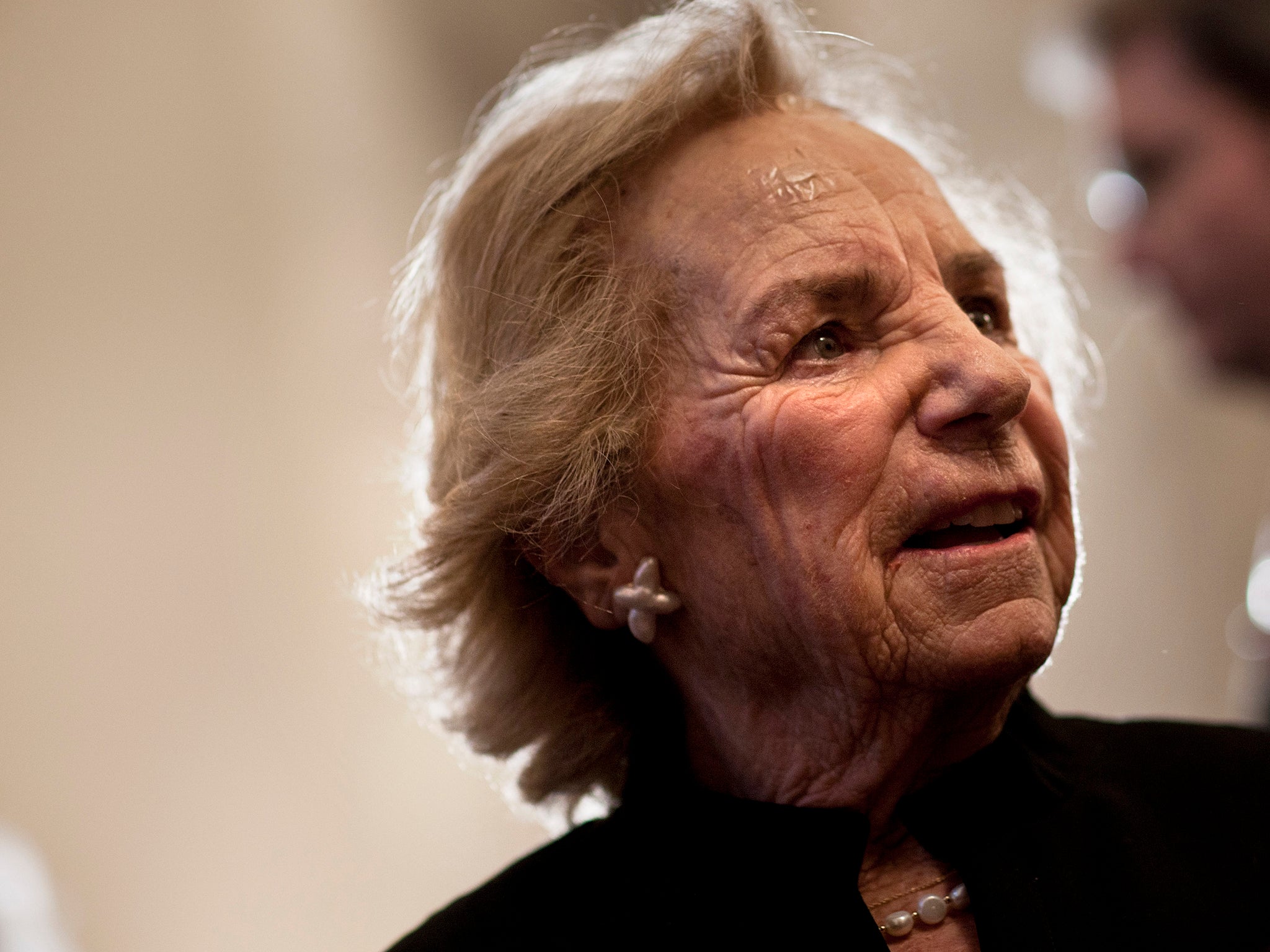
Ethel Kennedy, the widow of former senator Robert F Kennedy and steely-eyed matriarch of America’s elite political dynasty who leaves behind her own strong legacy of human rights work, has died at the age of 96.
Her death was announced by her grandson Joe Kennedy III in a post on X on Thursday, coming just days after the family announced she had suffered a stroke and was “comfortable” in hospital.
“It is with our hearts full of love that we announce the passing of our amazing grandmother, Ethel Kennedy. She died this morning from complications related to a stroke suffered last week. Along with a lifetime’s work in social justice and human rights, our mother leaves behind nine children, 34 grandchildren, and 24 great-grandchildren, along with numerous nieces and nephews, all of whom love her dearly,” said the former Massachusetts Congressman.
“She was a devout Catholic and a daily communicant, and we are comforted in knowing she is reunited with the love of her life, our father, Robert F. Kennedy; her children David and Michael; her daughter-in-law Mary; her grandchildren Maeve and Saoirse; and her great-grandchildren Gideon and Josie. Please keep her in your hearts and prayers.”
Kennedy’s life was famously marred by tragedy, with the tragic deaths of both her parents in a private plane crash, her husband’s assassination in 1968, and the deaths of two of her children – one to an accidental overdose, the other to a skiing accident.
But despite her personal heartbreak, Kennedy was well-known for her dedication to advancing the human rights of others.
She founded the Robert F Kennedy Human Rights organization in her late husband’s name, advocating for better living and working conditions around the world, in part by drawing attention to the climate crisis. For decades, she dedicated her time to the high-profile public service that came with both the privileges and burdens of the famous Kennedy name.
Born Ethel Skakel on April 11 1928 in Chicago, Illinois, she was the sixth of seven children to Anne and George Skakel.
The children were raised Catholic in what was, at first, a working-class family.
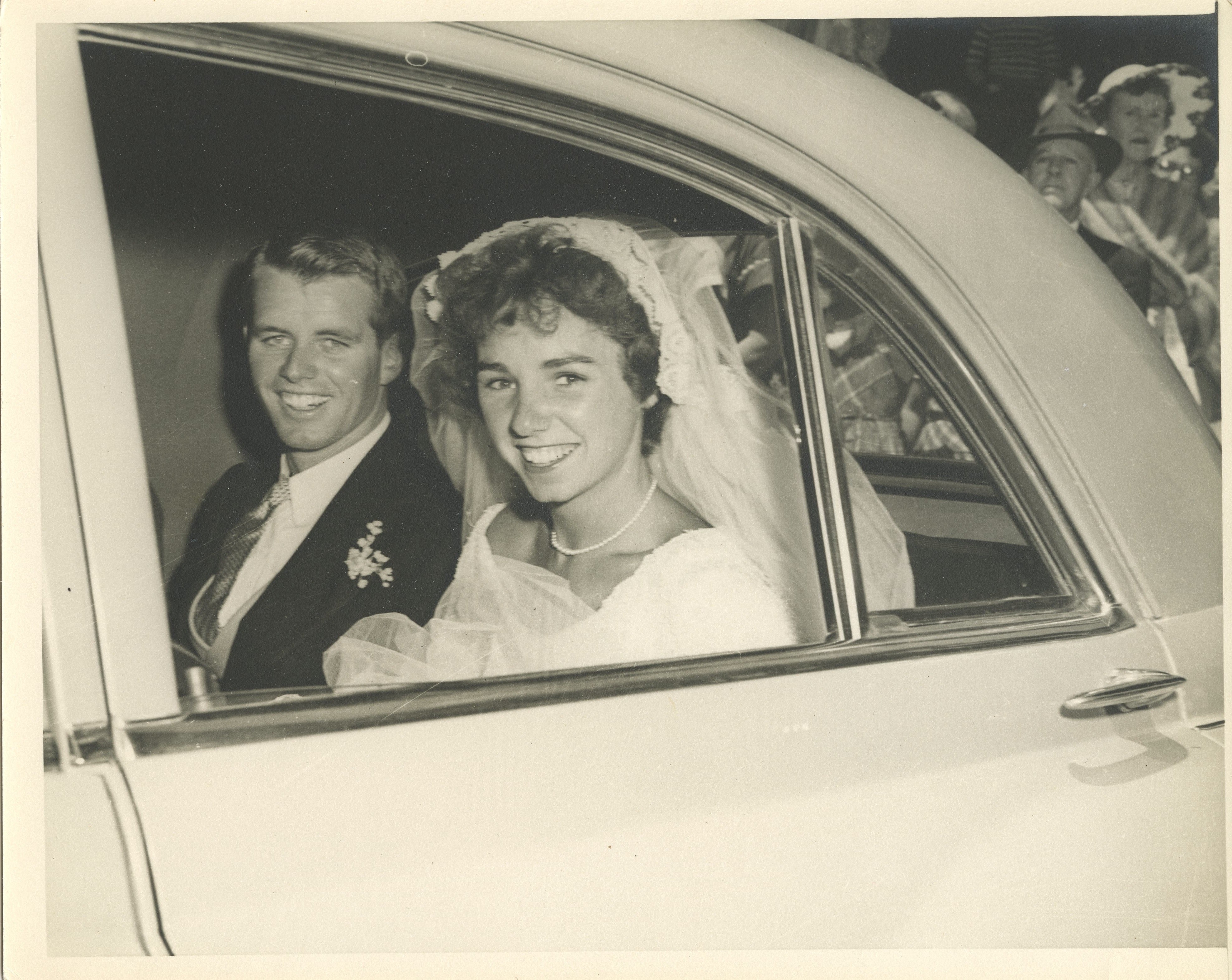
Their fortunes quickly transformed when George cofounded the coke and coal business Great Lakes Cola & Coke Company with some of his coworkers on the railroad. The business took off and eventually became the hugely successful Great Lakes Carbon Corporation.
With their newfound wealth, the family upped sticks and moved to the wealthy enclave of Greenwich, Connecticut. Kennedy was just five years old at the time of the move and went on to attend elementary and secondary school there.
It was while attending university at the Manhattanville College of the Sacred Heart that she then met and became friends with Jean Kennedy — the sister of her future husband Robert F Kennedy.
In 1945, Jean introduced a then-17-year-old Kennedy to Robert while on a skiing trip in Quebec, Canada.
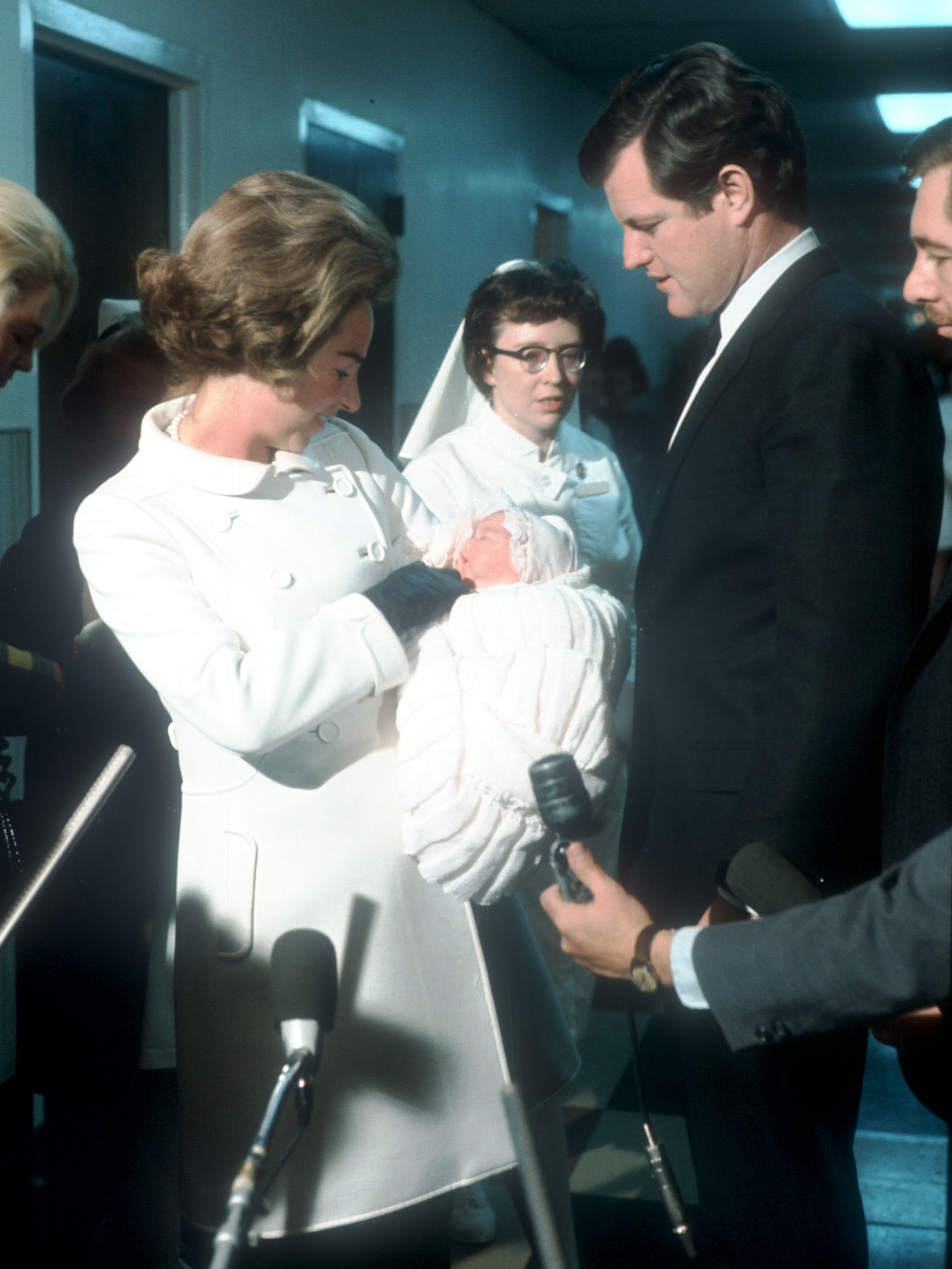
Five years later, the two married and began a life together.
By all accounts, Kennedy is said to have embraced her new identity as part of the prominent political dynasty and all the trappings of wealth, glamor and press speculation, as well as the hard work, expectations and intense pressure, that came with it.
In July 1951, around one year after the couple wed, Kennedy gave birth to their first child Kathleen.
Over the next 17 years, Kennedy would give birth to 10 other children: Joseph in 1952, Robert F Kennedy Jr in 1954, David in 1955, Mary “Courtney” in 1956, Michael in 1958, Mary “Kerry” in 1959, Christopher in 1963, Matthew “Max” in 1965, Douglas in 1967 and Rory in 1968.
In the early days of their marriage, Kennedy took on a largely traditional role, bringing up the children while supporting her husband as he pursued his political career.
But privately, Kennedy was known for her feisty personality and tough parenting style.
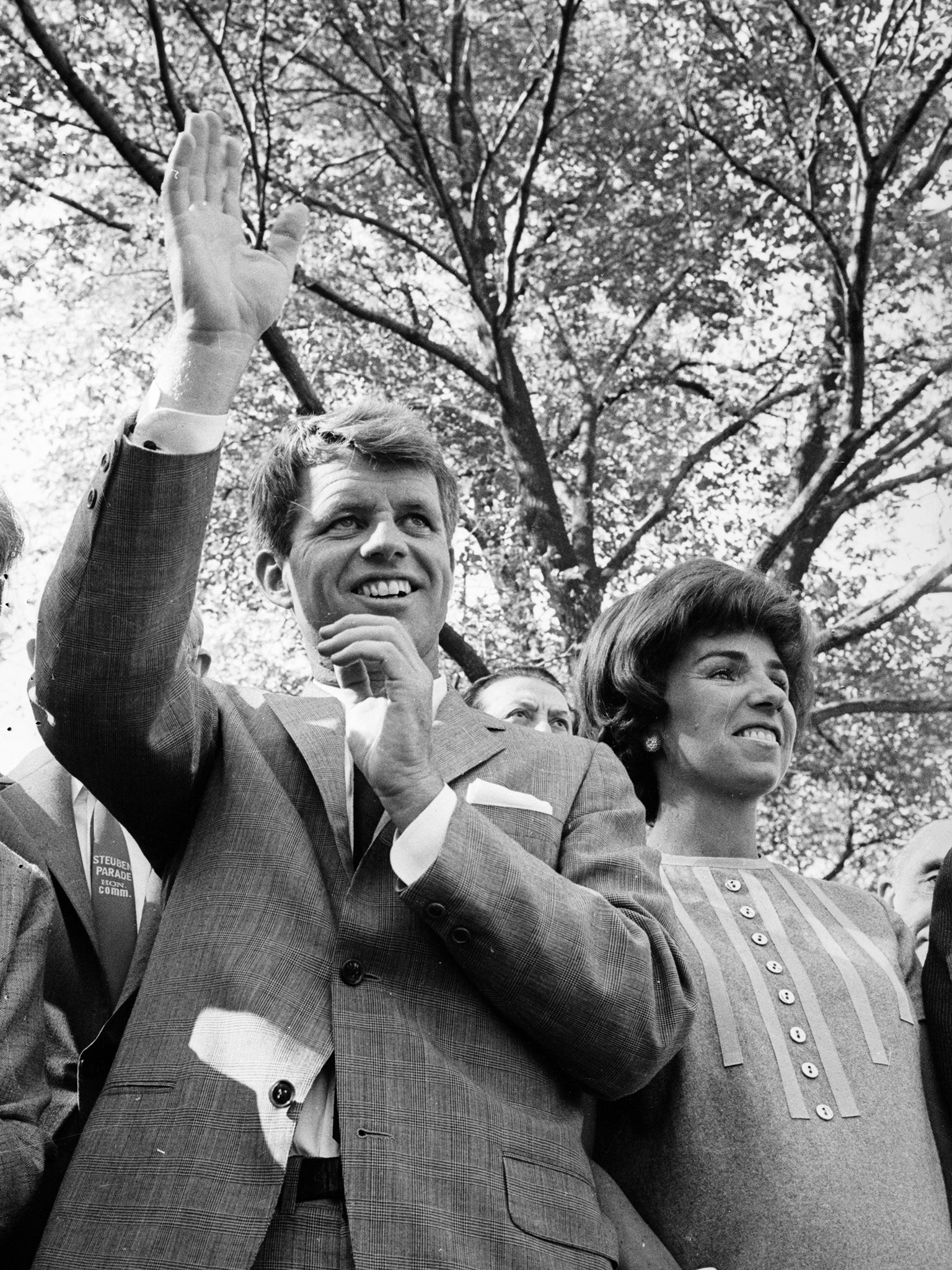
In the 2012 documentary Ethel, directed by daughter Rory, she was remembered for encouraging competitiveness, independence and political activism in her children from a young age.
And Kennedy also became more politically active over the years, campaigning for both her husband and brother-in-law in their pursuits in Washington.
When her husband became the chief counsel for the Senate Permanent Subcommittee on Investigations in 1957, Kennedy would often visit Capitol Hill daily to attend hearings — with her many children in tow, according to a 1987 Architectural Digest article.
Then, when John F Kennedy was elected president in 1960, he appointed his younger brother Robert as his attorney general. As a result, Kennedy and her husband bought a 13-bed mansion, Hickory Hill, in Virginia, from JFK and Jackie and their ever-expanding brood moved in.
There, Kennedy and her husband became known for hosting spirited social events.
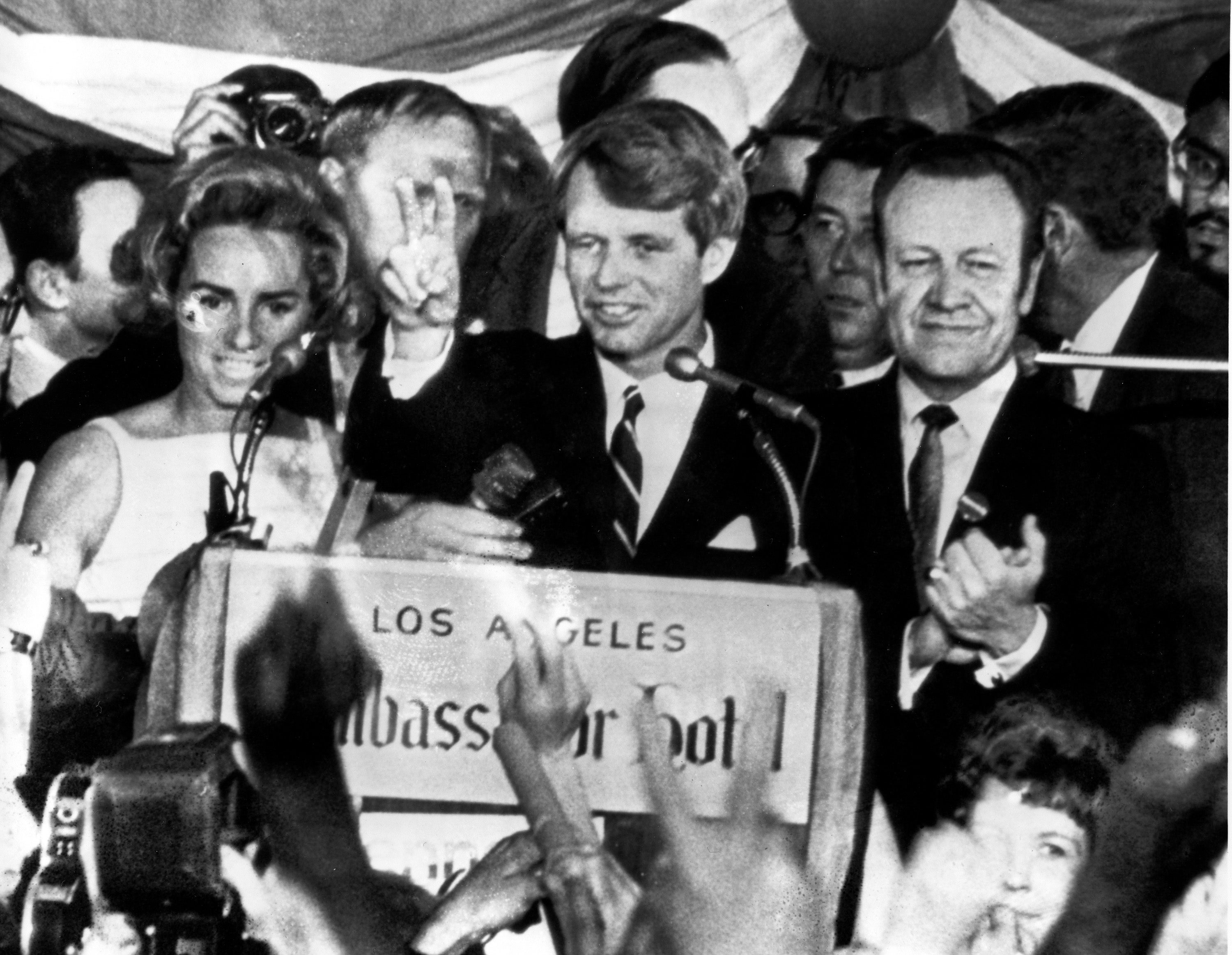
The house would often be filled with campaign managers and speech writers who would later recall the Sound of Music-esque nightly ritual of the many children coming to bid their parents goodnight while they entertained their guests.
In 1963, the family was rocked by the assassination of JFK.
After his brother’s death, Robert pursued his own political ambitions – first with a successful run for the US senate, then with his own bid for president.
Kennedy supported him by joining him on the campaign trail — something she thoroughly enjoyed.
But, on June 5 1968, mere minutes after Robert won the California Democratic primary and celebrated his victory in the ballroom of the Ambassador Hotel in Los Angeles, he was shot. He died from his injuries in hospital the next day.
Six months later, Kennedy gave birth to their youngest child Rory – as a widow and single mother of 11.
Kennedy declared she would never remarry due to her Catholic faith.

Instead, she dedicated the remainder of her life to honoring her husband’s memory and furthering the Kennedy clan.
Just months after Robert’s death, she established the Robert F Kennedy Center for Justice & Human Rights (now known as Robert F Kennedy Human Rights).
The nonprofit set out to create a team of leaders that would advocate to expose injustices, heal pain and suffering and work to enact positive change in governments and corporations around the world.
At its opening, Kennedy said: “[RFK] wanted to encourage the young people and to help the disadvantaged and discriminated against both here and abroad, and he wanted to promote peace in the world.”
For the next 50 years, Kennedy dedicated her life to doing exactly that.

She marched with Cesar Chavez, crossed the Edmund Pettus Bridge with John Lewis, sat with Native Americans at Alcatraz, demonstrated outside South African and Chinese embassies, pulled tires out of the Anacostia River and more. She also co-chaired the Coalition of Gun Control.
Even at the age of 90, Kennedy joined a hunger strike in protest of the Trump administration’s policy to separate migrant families at the US-Mexico border.
Kennedy’s desire to promote peace and human rights across the globe was often seen to be, at least in part, her way of responding to the many tragedies she faces in life.
Early in her marriage to RFK in 1955, Kennedy’s parents died together in a private plane crash.
Her husband and brother-in-law were both assassinated.

Her son, David, died of an overdose while her son, Michael, was killed in a skiing accident.
Two of her granddaughters and her great-grandson also tragically died young.
But what endured throughout Kennedy’s life was the tough-as-nails personality she was well-known for.
While presenting her with the Presidential Medal of Freedom – the highest civilian honor – in 2014 for her dedication to social justice, then-President Barack Obama said it best:
“As her family will tell you, and they basically occupy this half of the room, you don’t mess with Ethel.”
READ MORE AT THE INDEPENDENT
Related:
- « Previous Page
- 1
- 2
- 3
- 4
- 5
- …
- 74
- Next Page »


